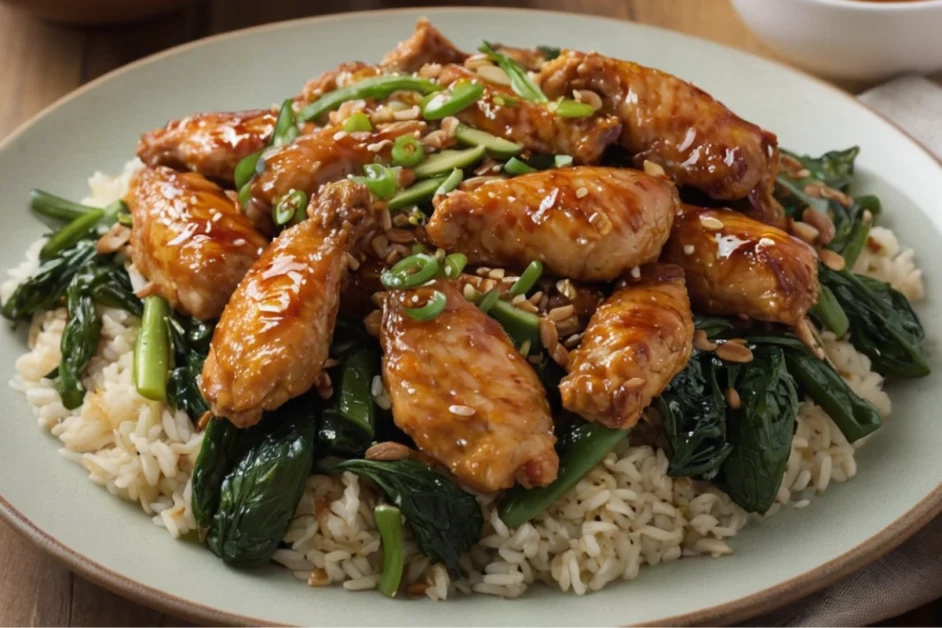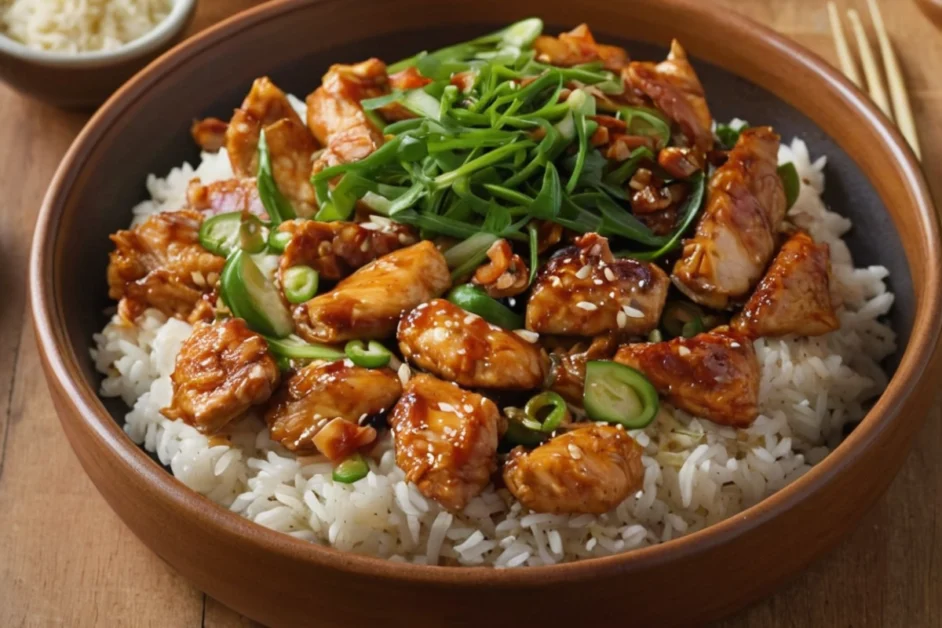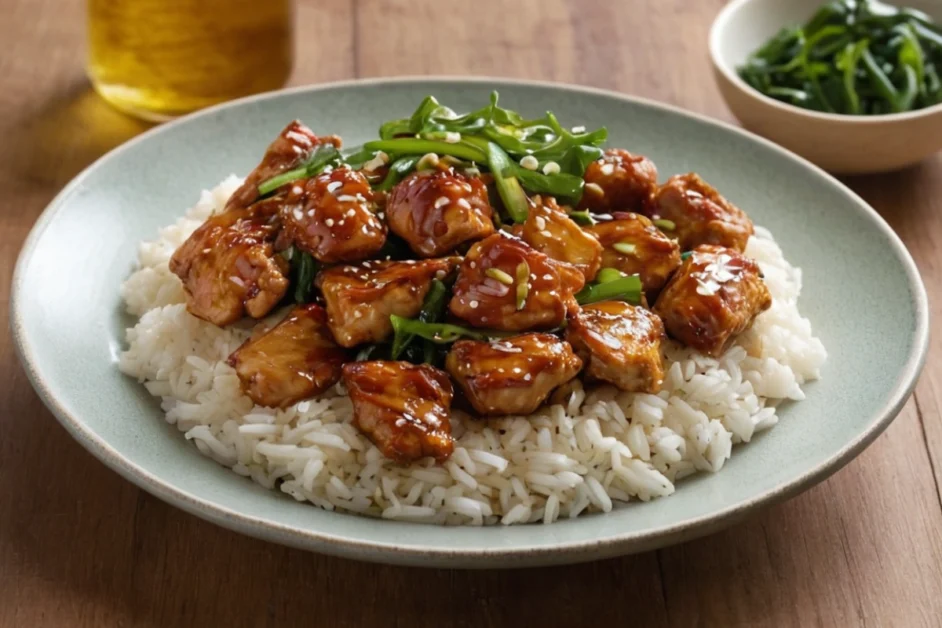Korean chicken dishes are celebrated for their bold, spicy, and umami-packed flavors that seamlessly blend sweetness, heat, and savory richness. Paired with rice, these flavors become even more satisfying, creating a comforting yet vibrant meal that appeals to all tastes. Whether you’re making it as a quick weeknight dinner or preparing it for meal prep, rice with Korean chicken is versatile, delicious, and adaptable for various dietary preferences.
In this article, we’ll dive into a step-by-step guide for creating the perfect rice with Korean chicken, discuss the key ingredients that define the dish, explore cooking methods, and suggest several variations you can try at home. If you’re a fan of flavorful, easy-to-make dishes, check out this Easy Bibibop Copycat Chicken Recipe for another simple yet tasty chicken bowl recipe. Additionally, if you’re interested in trying a hearty weeknight meal, this 3-Ingredient Sloppy Joe Recipe offers a quick and delicious alternative.
Key Ingredients in Rice with Korean Chicken
To master the perfect Korean chicken dish, it’s essential to understand the core ingredients that give the dish its signature taste. Each component contributes to the flavor, texture, and complexity of the meal:
1. Chicken
For this dish, you can choose between chicken thighs and chicken breasts. Thighs are typically preferred because they are juicier and richer in flavor, while chicken breasts are a leaner option that works equally well if you’re looking for a lighter meal. The key is marinating the chicken to allow it to absorb the flavors fully.
2. Gochujang (Korean Red Chili Paste)
The star of the marinade, gochujang is a fermented chili paste that offers a balance of sweetness, heat, and umami. Its complex flavor profile comes from the fermentation process, which deepens the taste and gives the dish a bold kick. Gochujang is what makes this dish distinctly Korean and sets it apart from other chicken recipes.
3. Soy Sauce
Soy sauce is a critical component that brings in the salty, savory elements of the marinade. It balances the sweetness of gochujang and enhances the umami profile of the chicken. The saltiness also helps to tenderize the chicken, making it flavorful and succulent after cooking.
4. Garlic and Ginger
are foundational aromatics in Korean cooking. Garlic brings an earthy, pungent flavor, while ginger adds warmth and a slight peppery bite. Together, they create an aromatic base that complements the spiciness and sweetness of the gochujang.
5. Rice
Rice is the perfect neutral base that absorbs the flavors of the saucy chicken. Traditional Korean dishes often use short-grain rice, which has a sticky texture that clings to the chicken and sauce, making every bite flavorful. However, jasmine rice is a lighter, fluffier alternative that works well if you prefer a less sticky texture.
6. Additional Flavorings
To further enhance the dish, additional ingredients such as honey, sesame oil, and rice vinegar can be added to the marinade:
- Honey or brown sugar introduces sweetness, which balances the heat from the gochujang.
- Sesame oil adds a nutty richness and aromatic finish.
- Rice vinegar brings acidity that cuts through the richness of the chicken and adds brightness to the dish.
Choosing the Right Rice for Korean Chicken

The rice you choose can have a significant impact on the overall experience of eating Korean chicken. Let’s break down the most common types of rice used for this dish and how they affect the texture and flavor:
- Short-Grain Rice: Sticky and slightly chewy, short-grain rice is commonly used in Korean meals. This type of rice holds together well, making it ideal for scooping with chopsticks and for soaking up the savory sauce from the chicken. Its texture complements the saucy and spicy nature of Korean chicken.
- Jasmine Rice: If you’re looking for a lighter option, jasmine rice offers a fluffy, aromatic texture. It’s less sticky than short-grain rice but still absorbs the marinade’s flavors beautifully. The subtle fragrance of jasmine rice also adds an extra layer of complexity to the dish without overpowering the boldness of the chicken.
For more tips on how to cook the perfect rice to pair with Korean chicken, visit this step-by-step guide to cooking Korean rice for a foolproof method.
Popular Cooking Methods for Korean Chicken
There are various ways to prepare Korean chicken, each offering a unique texture and flavor profile. Depending on your cooking preferences and available equipment, you can choose one of the following methods to make the dish:
1. Stir-Frying
Stir-frying is one of the quickest and easiest methods to cook Korean chicken. In this method, the marinated chicken is cooked over high heat in a hot skillet or wok. Stir-frying allows the chicken to develop a caramelized exterior while remaining juicy and tender inside. This method is perfect if you’re short on time but still want a flavorful dish.
2. Grilling
Korean chicken adds a smoky depth to the dish, enhancing the sweetness of the gochujang marinade. Grilling allows the chicken to char slightly on the outside, creating a nice contrast between the crispy exterior and the tender meat inside. Basting the chicken with additional marinade while grilling intensifies the flavors and keeps the meat moist.
3. Frying
For those craving a crispy texture, Korean fried chicken is the way to go. The chicken is first marinated, then coated in a light flour or cornstarch mixture before being fried to golden perfection. Korean fried chicken is famous for its ultra-crispy crust that remains crunchy even after being glazed in sauce. Serve it with a bowl of fried rice for a satisfying meal.
4. Braising
Braising involves slow-cooking the chicken in a broth or sauce made from gochujang, soy sauce, garlic, and ginger. This method results in tender, fall-apart chicken that has absorbed all the rich flavors of the marinade. Braised chicken is ideal for those who prefer a saucy, comforting dish that pairs perfectly with rice.
Each method provides a different texture and flavor experience, so feel free to experiment with the one that best suits your taste.
Step-by-Step Rice Recipe with Korean Chicken
Now that you’re familiar with the key ingredients and cooking methods, here’s a detailed step-by-step recipe for rice with Korean chicken:
Ingredients:
- 500g chicken thighs (boneless, skinless)
- 2 tablespoons gochujang (Korean red chili paste)
- 2 tablespoons soy sauce
- 1 tablespoon honey or brown sugar
- 1 tablespoon rice vinegar
- 3 cloves garlic, minced
- 1 tablespoon ginger, minced
- 2 cups cooked rice (short-grain or jasmine)
- 1 tablespoon sesame oil
- Scallions and sesame seeds for garnish
- Optional: sautéed vegetables like zucchini, carrots, or spinach
Instructions:
- Marinate the Chicken
In a bowl, whisk together the gochujang, soy sauce, honey, rice vinegar, garlic, and ginger. Add the chicken thighs to the marinade, ensuring they are fully coated. Cover and marinate the chicken for at least 30 minutes, or for deeper flavor, refrigerate overnight. - Prepare the Rice
While the chicken is marinating, cook the rice. Rinse the rice under cold water until the water runs clear, then cook according to the package instructions for either short-grain or jasmine rice. Once cooked, fluff with a fork and keep warm. - Cook the Chicken
Heat a tablespoon of oil in a large skillet over medium-high heat. Once hot, add the marinated chicken and cook for 5-7 minutes on each side until the chicken is fully cooked and has a nice caramelized crust. Remove from the heat and let the chicken rest for a few minutes before slicing. - Assemble the Dish
Divide the cooked rice into serving bowls. Top each bowl with the sliced Korean chicken. Drizzle with sesame oil and garnish with scallions and sesame seeds. Serve alongside sautéed vegetables or a side of kimchi for added flavor.
Variations of Rice with Korean Chicken
The beauty of rice with Korean chicken lies in its versatility. Once you’ve mastered the basic recipe, there are countless ways to customize the dish to suit your preferences. Here are a few popular variations to try:
1. Korean Chicken Bowl with Vegetables
For a more balanced meal, you can add sautéed vegetables like zucchini, spinach, or mushrooms to your bowl. This not only adds color and texture but also increases the nutritional value of the meal. Top the dish with a fried egg for extra richness and flavor.
2. Korean Fried Chicken with Rice
If you’re craving something crispy, consider making Korean fried chicken. Marinate the chicken as usual, then coat it in cornstarch or flour before frying it until golden and crispy. Serve the fried chicken over steamed rice and drizzle with additional gochujang sauce for a deliciously indulgent meal.
3. Spicy Gochujang Chicken Rice Bowl
For spice lovers, increasing the amount of gochujang in the marinade is a must. You can also add Korean chili flakes for an extra kick. Serve the spicy chicken over a bed of rice and garnish with kimchi and cucumber slices for a refreshing contrast to the heat.
4. Korean Chicken Fried Rice
If you have leftovers, transform them into a new meal by making Korean chicken fried rice. Stir-fry day-old rice with your leftover marinated chicken, scrambled eggs, and vegetables like carrots, peas, and onions. This quick and easy one-pan meal is perfect for using up leftovers while creating something new and delicious.
5. Sweet and Spicy Korean BBQ Chicken
For a fusion twist, you can prepare a Korean BBQ-style chicken by grilling the marinated chicken and brushing it with a glaze made from honey and extra gochujang. Serve it with rice, pickled vegetables, and a drizzle of sesame oil to create a balance of sweet, savory, and spicy flavors.
Health Benefits of Korean Chicken and Rice

In addition to being a flavorful and satisfying meal, Korean chicken with rice offers several health benefits:
- Lean Protein: Both chicken thighs and chicken breasts provide a good source of lean protein, which is essential for muscle repair and overall health.
- Fermented Ingredients: The use of gochujang introduces beneficial probiotics due to its fermentation process, which can help improve digestion and support gut health.
- Balanced Meal: By combining protein from the chicken, carbohydrates from the rice, and healthy fats from the sesame oil, this dish is a well-rounded meal. Adding vegetables increases the fiber and vitamins, further boosting the nutritional value of the meal.
- Spices and Anti-Inflammatory Benefits: The inclusion of ginger and garlic in the dish offers anti-inflammatory properties that may help reduce inflammation and improve immunity.
Frequently Asked Questions (FAQs)
1. What kind of rice goes best with Korean chicken?
Short-grain rice is the traditional choice for Korean dishes because of its sticky texture, which complements saucy dishes like Korean chicken. However, jasmine rice is also a good option if you prefer a fluffier, less sticky texture.
2. How spicy is gochujang?
Gochujang has a mild to moderate spice level, depending on the brand. You can adjust the spice level in your dish by adding more or less gochujang to the marinade. For a milder flavor, reduce the amount of gochujang, or for more heat, add Korean chili flakes.
3. Can I use other cuts of chicken besides thighs?
Yes, you can use chicken breasts if you prefer a leaner option. You can also use drumsticks or wings if you like. Keep in mind that cooking times will vary depending on the cut of chicken.
4. What are common garnishes for rice with Korean chicken?
Common garnishes include scallions, sesame seeds, and kimchi. These garnishes add freshness, texture, and extra flavor to the dish. Kimchi also provides a probiotic boost due to its fermentation process.
Conclusion
Rice with Korean chicken is a versatile, flavorful dish that offers the perfect balance of sweetness, spice, and umami. Whether you’re making it for a quick dinner or preparing it ahead of time for the week, this dish is sure to become a staple in your kitchen. The combination of marinated chicken and perfectly cooked rice creates a meal that is both satisfying and nutritious.
For more inspiration on Korean cooking, check out this Easy Bibibop Copycat Chicken Recipe or try this 3-Ingredient Sloppy Joe Recipe for another simple and tasty weeknight meal.
